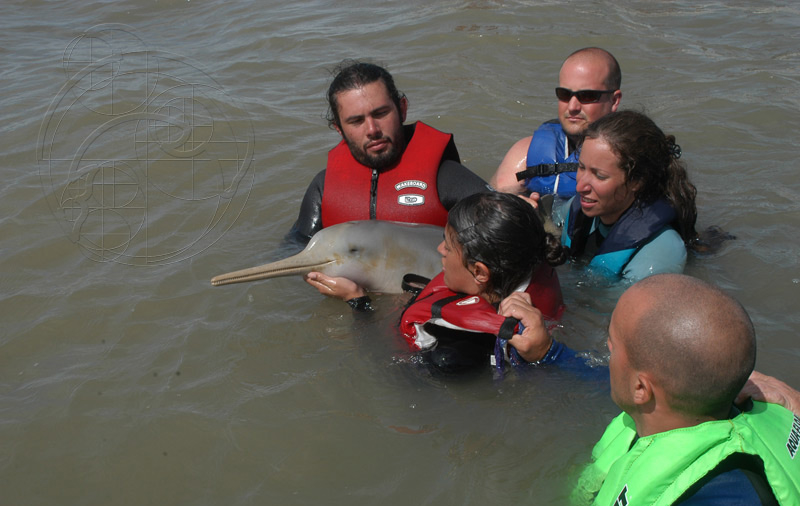This 2008 photo shows researchers preparing to release a tagged franciscana dolphin in Argentina. Dolphins were held for a brief period while satellite-linked tags were applied and then the dolphins were released on site.
Lessons Learned in Sarasota Are Applying to Dolphin Conservation in Argentina and Brazil
With research initiated in 1970, the Sarasota Dolphin Research Program demonstrated for the first time the residency of a community of inshore bottlenose dolphins. Subsequent work showed that the residency for Sarasota Bay dolphins was long-term, across generations and decades.
During the 1980s and 1990s, our photographic identification surveys of Tampa Bay, Charlotte Harbor, and Pine Island Sound demonstrated the existence of similar communities up and down the central west Florida coast.
Our extended surveys this year in southeast Tampa Bay, near the site of the 215-million gallon spill of polluted water from the decommissioned Piney Point phosphate mine, provide further evidence that the next dolphin community north of Sarasota Bay also exhibits long-term residency.
Among the dolphins we’ve seen during Piney Point surveys are Bumpy Fin, first observed in Tampa Bay in 1984, Grasshopper (1989), along with Big Shout (1992) and her calf, Holly (2000). We’ve also seen Grasshopper’s two younger siblings, Allison (2000) and F240 (2004). These three calves — likely sired by the same father, FB28 — are the offspring of Pecan Sandie, the first Florida dolphin ever tagged with a satellite-linked transmitter. Her 1990 tagging showed us how dolphin ranges in Tampa Bay can overlap the northern extreme of the Sarasota dolphin community range. And the dolphins noted above continue to show this pattern of overlap.
You can read more about Pecan Sandie’s movements in the paper “Satellite-monitored movements and dive behavior of a bottlenose dolphin (tursiops truncatus) in Tampa Bay, Florida,” published in the journal Marine Mammal Science.
A new paper demonstrates the residency of another dolphin species in another part of the world.
In “Tagging, ranging patterns, and behavior of franciscana dolphins (Pontoporia blainvillei) off Argentina and Brazil: Considerations for conservation” in the journal Marine Mammal Science, I and my co-authors have also shown how understanding things like the home ranges of dolphins can help increase the effectiveness of conservation efforts.
We were first invited by Pablo Bordino to study franciscana dolphins in 2003 and have been working closely with partners in Argentina and Brazil to support conservation for this species — one of the most threatened cetaceans in the Southwestern Atlantic — ever since.
Information on ranging patterns of franciscanas was needed to understand threat exposure for specific population units. Franciscana dolphins largely lack the distinctive natural markings that would allow for a photographic identification program similar to the one we’ve developed for Sarasota Bay dolphins, so Pablo asked us to collaborate on telemetry studies.
In 2005, we began by attaching VHF radio-tags to the franciscanas’ fins and, during 2006-2013, we transitioned to satellite-linked transmitters.
Thanks to this research, today we know that franciscana dolphins have definable home ranges and that we can relate specific geographic-based threats to franciscana population units. That, in turn, will help local resource managers put in place more effective conservation measures to help save the species.
I’d like to recognize my co-authors on this project:
- Marta J. Cremer, Laboratory of Ecology and Conservation of Marine and Coastal Tetrapods, University of the Joinville Region – UNIVILLE, São Francisco do Sul, Santa Catarina, Brazil
- Leonardo G. Berninsone, AquaMarina – Centro de Estudios en Ciencias Marinas, Pinamar, Buenos Aires, Argentina and Departamento Conservación, Ecoparque Buenos Aires, Secretaría de Ambiente GCBA, Argentina
- Diego Albareda, AquaMarina and Departamento Conservación, Ecoparque Buenos Aires, Secretaría de Ambiente GCBA, Argentina
- Krystan A. Wilkinson, CZS-SDRP
- M. Andrew Stamper, Disney’s Animals, Science, and Environment, Lake Buena Vista, Florida
- Renan L. Paitach, Laboratory of Ecology and Conservation of Marine and Coastal Tetrapods
And most of all, I’d like to recognize Pablo Bordino, who established Fundación AquaMarina in 1998 to help protect the franciscana dolphins. Sadly, Pablo died in 2018, but today this paper is one among his many contributions to dolphin conservation.
Here’s to fair winds and following seas my friend.
Randy Wells
Director, Chicago Zoological Society’s Sarasota Dolphin Research Program





